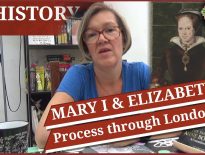Yes, you read that correctly! On this day in Tudor history, 4th August 1540, thirteen men were executed in London - 12 by being hanged, drawn and quartered, and one by being hanged. Awful!
In today's talk, I explain who these 13 men were and why they were attainted by Parliament and executed.
My videos on the Carthusian Martyrs:
Also on this day in history:
- 1549 – The Battle of Woodbury Common, part of the Prayer Book Rebellion. The battle took place at 4am and happened when the rebels, who had been defending Clyst St Mary, marched to Woodbury Mill where Lord Russell and his troops had camped for the night. The rebels were defeated.
- 1557 – Burial of Anne of Cleves, fourth wife of Henry VIII, at Westminster Abbey.
- 1560 – Baptism of Sir John Harington, courtier, translator and author, in the church of All Hallows, London Wall. His godparents were Elizabeth I and William Herbert, 2nd Earl of Pembroke. In his “New Discourse of a Stale Subject, called the Metamorphosis of Ajax” (1596), Harington outlined his design for a flush toilet – a privy with a cistern and flush valve. The Ajax, as it was called, was eventually installed at Richmond Palace.
- 1566 – Death of Sir Martin Bowes, goldsmith, politician, Lord Mayor of London and Under- Treasurer of the Royal Mint in the Tower of London. He was buried at St Mary Woolnoth, Lombard Street, London.
- 1578 – Death of soldier Thomas Stucley at the Battle of Alcazar. Stucley was fighting against the Moors, with King Sebastian of Portugal, when his legs were blown off by a cannon shot.
- 1598 - William Cecil, 1st Baron Burghley, died at his home in London aged seventy-six. He was laid to rest at St Martin's Church, Stamford, in his home county of Lincolnshire.
- 1612 – Death of Hugh Broughton, scholar, theologian and Hebraist, in Cheapside, London. He was buried at St Antholin's Church. Broughton spent the last twenty years of his life petitioning for a new translation of the Bible. His works included “A Concent of Scripture” (1588), “An Epistle to the learned Nobilitie of England, touching translating the Bible from the Original” (1597) and “An Advertisement of Corruption in our Handling of Religion” (1604).



But Cromwell was dead so Henry was responsible for this persecution of these holy men. Sounds like a purge of the people connected to Arthur Lord Lisle and Cardinal Pole. Both of these men were also of Plantagenet descent. The holy monks were being used as an example and are of course holy martyrs. Very sad. Pray for us and rest in peace. Amen